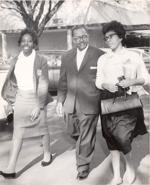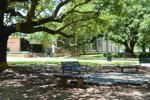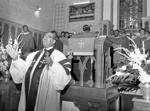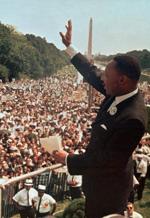Martin Luther King Jr.’s name and image pop up all over Baton Rouge, from brightly rendered murals to buildings like the Dr. Martin Luther King Jr. Community Center on Gus Young Ave.
But what sort of ties did King have to Baton Rouge during his lifetime? Though he wasn’t a frequent visitor to the city, the connections he did have played a vital role in his civil rights career.
It’s likely that King’s first visit to Baton Rouge came during a visit to Southern University while traveling on a speaking tour, probably in the early 1950s. Though he wasn’t widely famous at the time, he was already making waves in the African American church community.
There is a series of historical recordings at the LSU Libraries spotlighting King’s early encounters with Baton Rouge, with many of them brought together in a T. Harry Williams Center for Oral History podcast in 2010. In a 2006 interview, the late Huel Perkins — who had deep ties to Southern University, including a stint as dean of the school’s College of Arts and Humanities department from 1968 to 1978 — remembered one of King’s early visits.

The Rev. T.J. Jemison accompanies Mary Briscoe, left, and Sandra Ann Jones, two of nine Southern University students released on bond after being jailed in 1960 for their part in sit down demonstrations against segregated lunch counters.
“We had what was called a vespers series, and it was a lecture series,” Perkins told interviewers Petra Hendry and Dorian McCoy. “And he would come and he’d talk to us. We had no idea that he was going to become as famous as he would become. But we got a chance to meet him.”
A while later, King delivered his “The Three Dimensions of a Complete Life” speech at Southern. The visit, on Oct. 16, 1955, came during a busy time for the young pastor. Just six weeks later, he was in the thick of one of the most momentous civil rights protests in American history: the Montgomery bus boycott.
Though the boycott ended with the U.S. Supreme Court ruling segregation on public buses unconstitutional, it wasn’t the first large scale bus boycott in the United States.
That distinction belonged to Baton Rouge, where a bus boycott occurred two years earlier in 1953. Unsurprisingly, it was here that King turned his attention when he became a leading figure in the Montgomery operation.

Southern University’s campus on June 14, 2018. Martin Luther King Jr. visited the college on a speaking tour in his younger days.
The Baton Rouge boycotts were spearheaded by the Rev. T.J. Jemison, a Selma, Alabama, native who had come to Baton Rouge in June 1949 to become the pastor of Mount Zion Baptist Church.
Though it’s possible King contacted Jemison and other Baton Rouge protest leaders on multiple occasions, two events loom large: a call to Jemison shortly after the Montgomery protests began in 1955 and a visit to Baton Rouge itself the following year.
The initial call came when the Montgomery operation had been underway for three days. In his memoir, according to Stanford University’s Martin Luther King, Jr. Research and Education Institute, King wrote that Jemison’s “painstaking description of the Baton Rouge experience was invaluable.”
Later, as the boycott drew on, King traveled to Louisiana for a more in-depth, personal visit. Among the civil rights leaders and organizers he met — including Johnnie Jones, Raymond Scott and Jemison — was Dupuy Anderson.
Years later, in a 1994 interview with Maxine Crump, Anderson recalled that King was focused on the community aspect of the Baton Rouge protest.

The Rev. T.J. Jemison joins in as his congregation fills Mount Zion First Baptist church with song. From July 15, 1984, in the Sunday Advocate. Photo by John H. Williams.
“The most important thing he wanted to know (was) how we did to get the community to rally behind us,” Anderson recalled.
“To get the businesspeople, the filling stations and the like. Black businesses. To gain their support. I think Martin Luther’s plan was, regardless, they were going to boycott. But he knew they needed complete support of the Black community in order to carry out the bus boycott.”
In terms of boycott length, Montgomery greatly outstripped Baton Rouge by 13 months compared to eight days. But the techniques of both operations were similar, as were, in some ways, the legal complexities. Baton Rouge provided King with clues about how to keep his protest going.
The Baton Rouge boycott ultimately ended in a compromise. According to Dean Sinclair’s article Equal in All Places: The Civil Rights Struggle in Baton Rouge, 1953-1963, the city passed an ordinance reserving the first two seats on buses for white customers and the last one for black customers, with travelers being free to sit wherever they liked in-between.

Martin Luther King Jr. waves to the crowd during the 1963 March on Washington.
This caused resentment that segregation was present on the buses in any form, and it was another nine years before segregation on Baton Rouge’s buses was abolished completely.
In his interview, Anderson told Crump he wasn’t aware of King responding to the compromise. Yet, he said, that doesn’t mean it didn’t affect King’s decision making.
“It was my feeling this is the reason he was successful,” Anderson said. “He learned from it. He learned from it. We could have done the same thing in this community, you know. We started off a lot of things … in Baton Rouge, but we did not carry (them) to the complete finish.”

